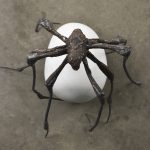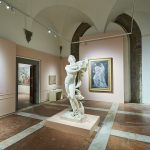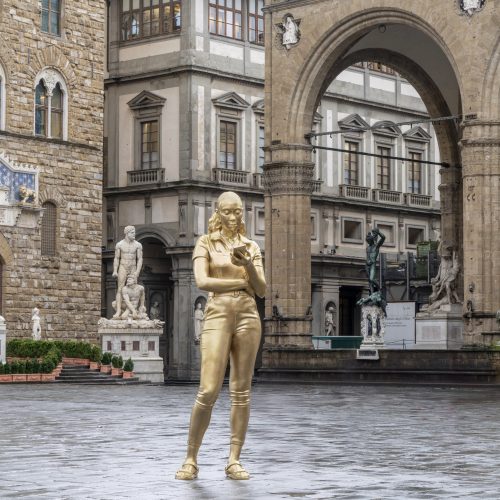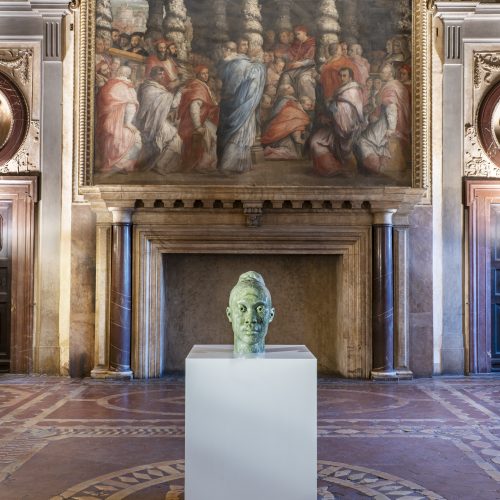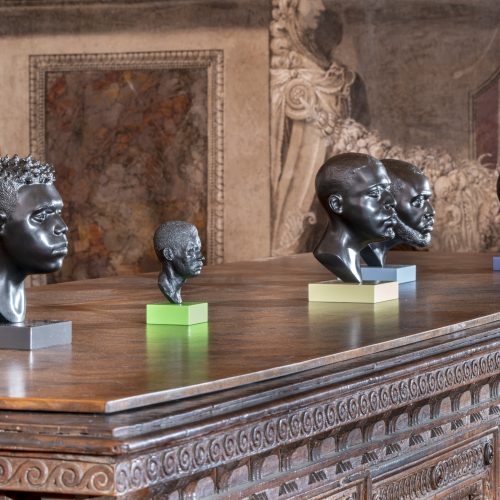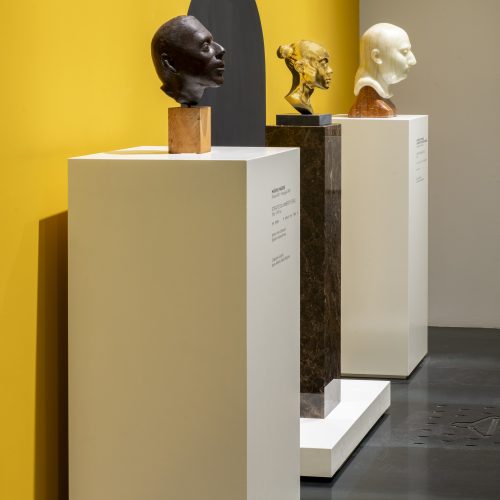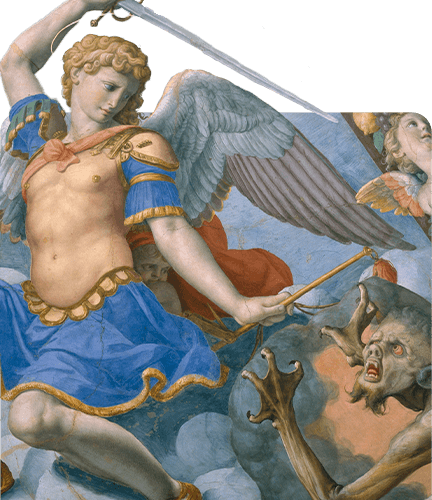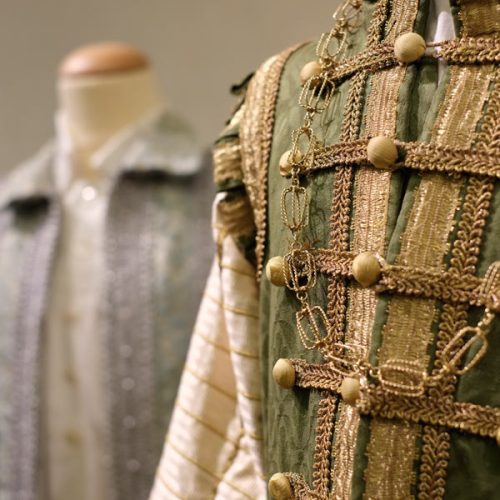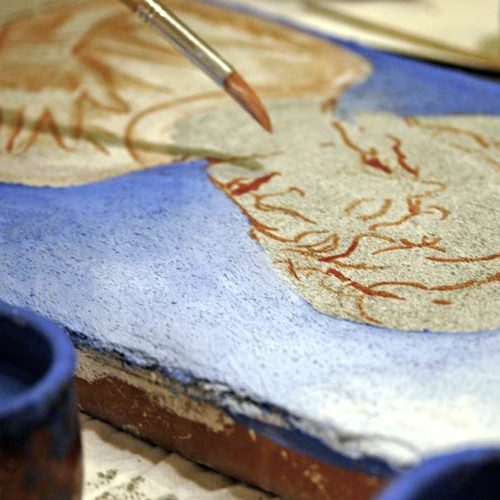Thomas J Price in Florence

al 11 June 25
Museo Novecento is pleased to present one of the most anticipated events of 2025 with the major exhibition of the renowned British sculptor Thomas J Price. As with past exhibitions featuring Jenny Saville, Rachel Feinstein, and Louise Bourgeois, the exhibition Thomas J Price in Florence, starting on Friday, March 14, will extend and engage with key locations in the historic center of Florence, including a major installation in Piazza della Signoria, where in previous years works by Jeff Koons, Jan Fabre, Urs Fischer, Francesco Vezzoli, and Henry Moore have been displayed. These works sparked much debate and, at the same time, accelerated the cultural renewal process the city had been longing for.
Thomas J Price draws our attention to the psychological embodiment of his fictional characters, highlighting the intrinsic value of the individual and subverting hierarchical structures. His works, inspired by diverse sources, are developed through a hybrid approach combining traditional sculpture and intuitive digital technology. Price balances presentation methods, materials, and scale to challenge our expectations and offer opportunities for a deeper human connection. The artist forces the viewer to consider how and why things are made, incorporating references to ancient, classical, and neoclassical sculpture alongside a sophisticated understanding of the symbolic power of materials. He leaves open questions, inviting us to doubt our ideological certainties, which form the foundation of our absolute thoughts regarding hierarchies and moral certainties.
Famous for his large-scale figurative sculptures displayed in public spaces and museum halls, Price will bring to the symbolic square of the Renaissance a nearly 4-meter-tall female figure made of bronze with a gold patina, titled Time Unfolding.
For Palazzo Vecchio, the artist has used traditional sculptural materials, such as bronze and marble, to create fictional characters that appear to be ordinary people. These characters, which combine undefined identities, invite reflection on preconceived attitudes toward power and value.
Through a Steady Gaze (2025), in polished Ming Green marble, Price enters into dialogue with the Sala Leone X, a room for state receptions and a symbol of the Medici family’s power and ties between Florence and the papacy. Opposite the frescoes celebrating Giovanni de’ Medici, elected pope in 1513 with the name Leone X, Price presents a critical reflection on the individuals that museums have represented throughout history. The anonymous yet universal face is a contrast to the portraits of illustrious men of the past, from princes Giulio de’ Medici to Pope Leo X, cardinals, dukes, painters and men of letters such as Pietro Bembo and Ludovico Ariosto.
The exhibition continues with five bronze heads exhibited on the Table of the Magistracy in the Sala delle Udienze. The room, frescoed by Francesco Salviati and used for court meetings and audiences, exalts the figure of the Roman military leader Marco Furio Camillo, who was compared to Duke Cosimo I de’ Medici. In this setting, Thomas J Price’s Bronze Heads, created between 2006 and 2021, invite us to think about the consistently stereotyped representation of Black people within European art history.
The critical view of cultural hierarchies and the system of sociopolitical privileges is also reflected in the contrast between the materials used by the artist. Bronze, historically considered a noble material for sculpture, is contrasted with contemporary Perspex bases and automotive spray paint.
In the Sala dei Gigli, A Place Beyond (2023), a young woman with a mobile phone in her hand, appears suspended in the space where Donatello’s famous bronze of Judith and Holofernes stands. The Renaissance masterpiece, mounted on an imposing plinth, depicts Judith in a heroic yet unsettling pose as she triumphantly raises the head of Holofernes, slain in his sleep and symbol of defeated evil. Donatello’s expressive realism transcends simple naturalism, and is sublimated into a message loaded with symbolic meaning and moral values that reflected the historical climate of the time. The work stood in Piazza della Signoria and became the symbol of the Florentine Republic.
In contrast, A Place Beyond portrays an ordinary person who could easily be mistaken for a visitor in the rooms of the Palazzo Vecchio, without any solemn or grandiloquent connotations, if not for the larger-than-life scale of the work. The base reduced to the bare minimum suggests that the figure has just interrupted her journey, stopping spontaneously in the middle of the room.
Despite being known for his figurative works, Price’s practice is underpinned with conceptual thinking that informs the way in which the viewer encounters the sculptures and their presence in space.
The exhibition continues at the former Leopoldine venue: exhibited in the Renaissance cloister of the Museo Novecento is the work A Kind of Confidence (2023). A young man, dressed in an elegant suit, stands at the centre of the garden, a quiet presence. His feet rest directly on the ground whilst his gaze evokes a feeling of suspended concentration. “It’s all about his shoes basically…The suit fits. But he’s not so sure…” Price states, “I have worked for a long time with the idea of vulnerability being actually a strength. The question is: How is he inhabiting the space he is in? Does he feel lesser than others? Does he feel he is being judged?” The bronze sculpture reflects Price’s investigation into the representation and historical stereotyping of Black people. A Kind of Confidence encourages questions about how the individual occupies the space around them and is subject to preconceived attitudes, exploring the delicate relationship between strength and fragility.
On display within the Alberto Della Ragione Collection are the sculptures Tasman Road, Figure 2 (2008) and Untitled (Icon 6) (2023). The title Tasman Road, from the Nude Series, references streets across London as well as the Dutch explorer Abel Tasman. The Western toponymy, traditionally associated with dominant white historical figures, is countered by a Black man, whose figure is captured in a vulnerable and seemingly melancholy yet steadfast pose.
Untitled (Icon 6) by Thomas J Price is positioned in a dialogue between eras and styles, between Antonietta Raphaël Mafai’s Ritratto di Emilio Jesi [Portrait of Emilio Jesi] (1940), made of onyx, and Marino Marini’s Ritratto di Lamberto Vitali [Portrait of Lamberto Vitali] (c.1936-1937), modelled in plaster and wax. These two busts are testaments to a complex historical period: Marini portrayed his friend, art historian and collector Vitali, while the piece by Raphaël immortalises the trusted benefactor and patron who took her and her family following in the enactment of the racial laws of 1938. The artist, of Jewish-Latvian origin, was forced to flee Rome, where she would only return in 1943.
Price’s experience at the Victoria and Albert Museum in London, which he visited frequently, profoundly influenced his artistic training, immersing him in the study of traditional ancient portraiture. His work, particularly his investigation into the language, materials and techniques of sculpture, is widely reflected in the museum’s permanent collection. The aluminium composite head gilded with gold brings together contemporary 3D printing and digital sculpting with echoes of the iconography of ancient sculpture, from Mycenaean funerary masks to Roman busts in gold, the mask of Tutankhamen and the Hercules of the Forum Boarium. Placing the head of an introspective contemporary figure rendered in luxurious gold on a slate base and a quartzite plinth, the sculpture exudes a powerful cultural resonance. Hieratic and solemn, the work Untitled (Icon 6) is not only a silent messenger of past traditions but also explores the modern conception of the meaning of sculpture.
Museo Novecento from 14.03 to 11.06.2025
Piazza della Signoria from 14.03 to 14.09.2025

